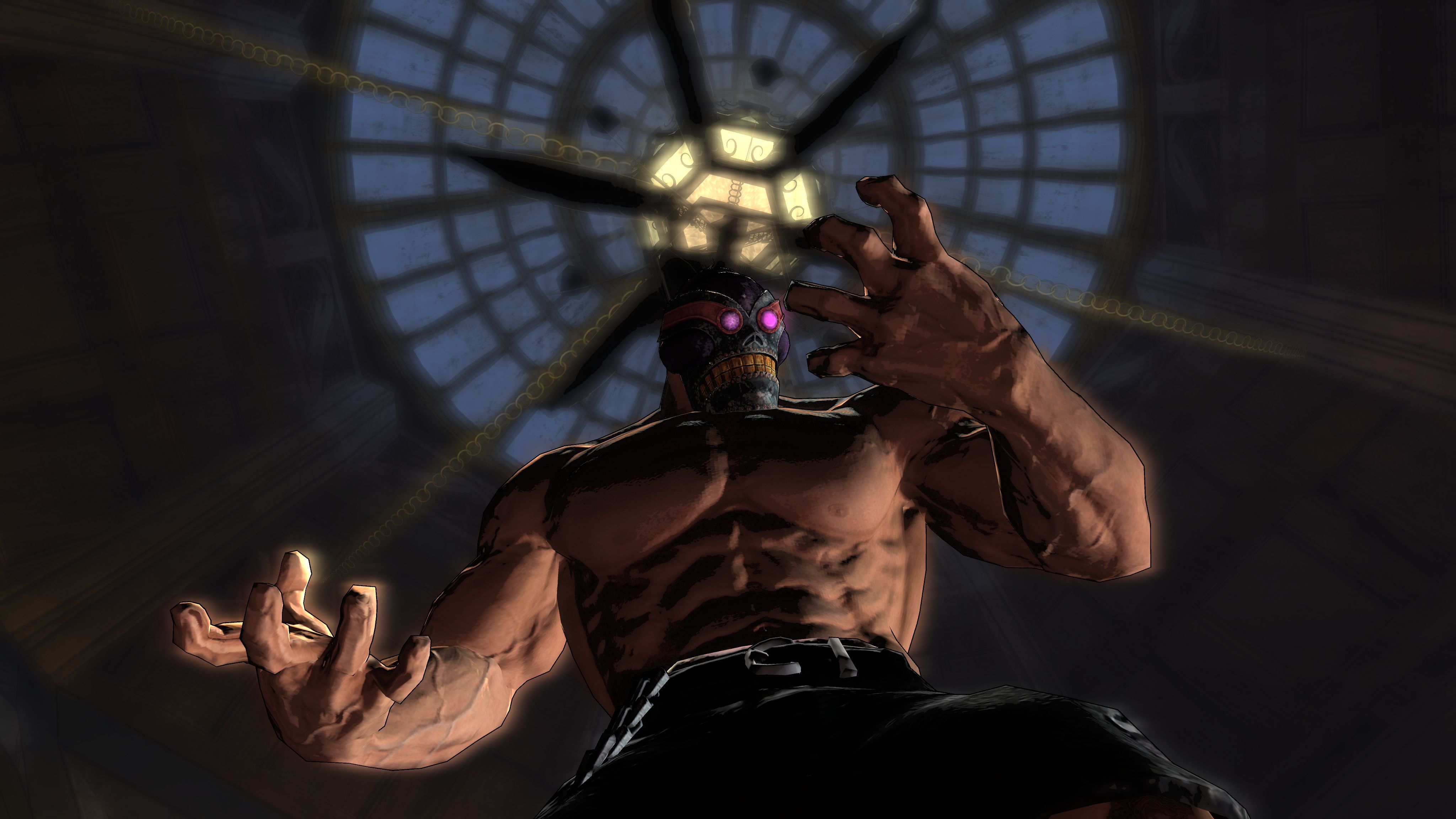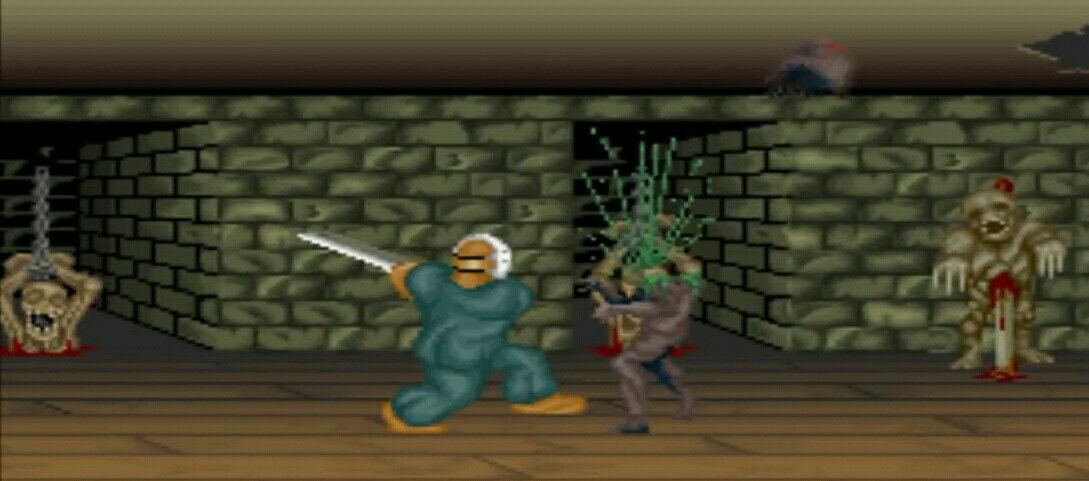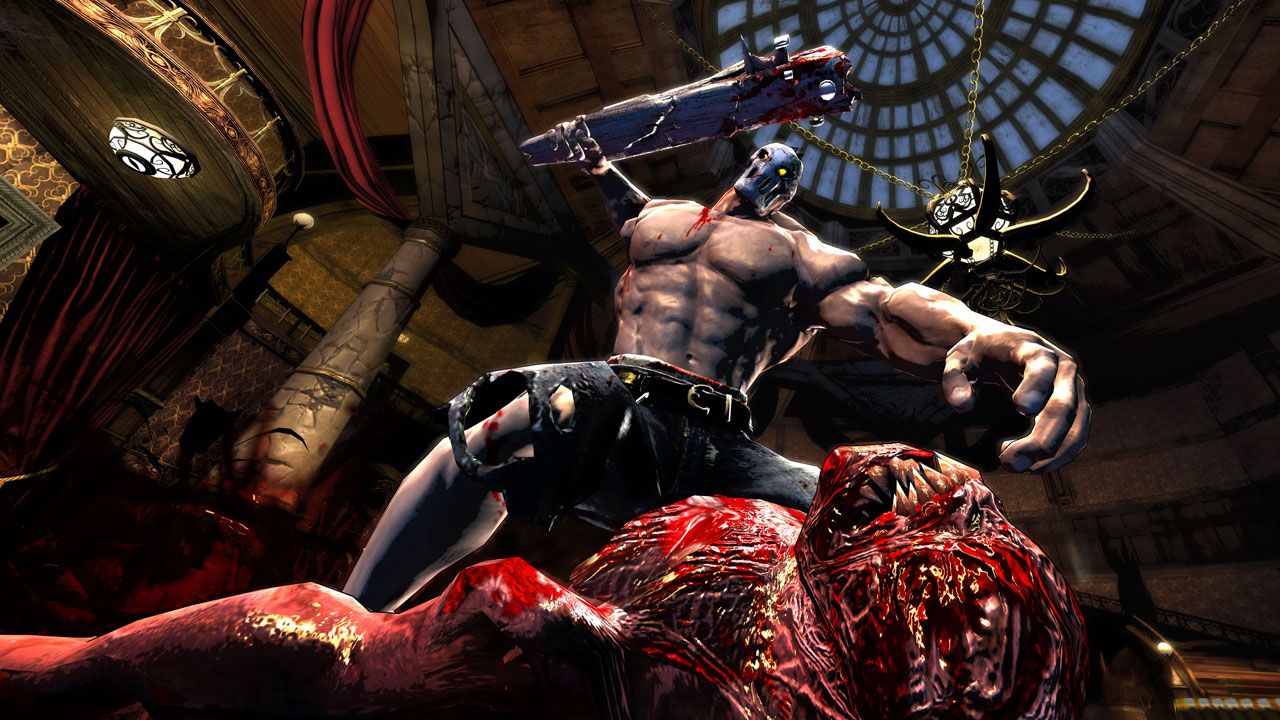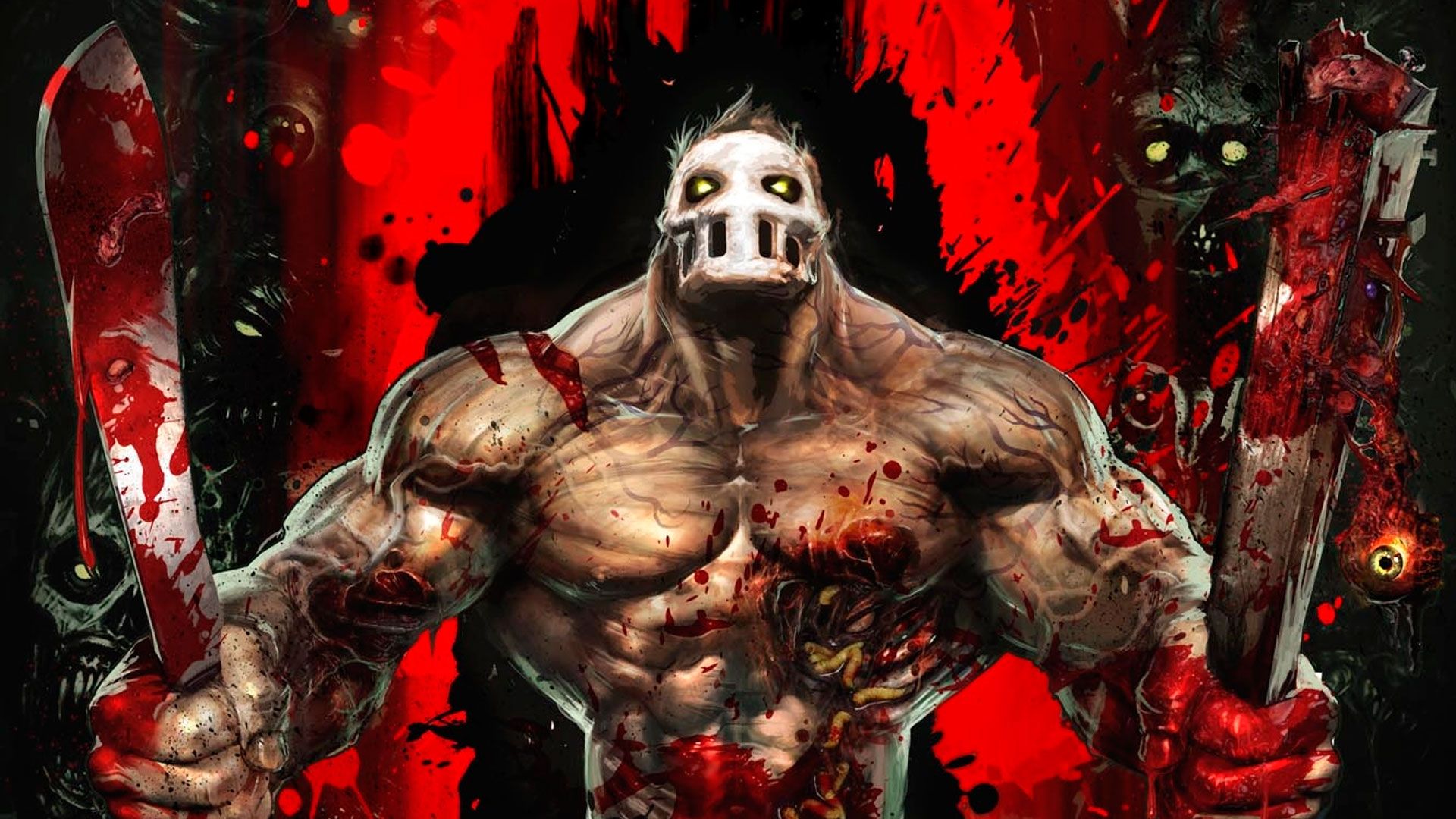When we think of horror games, our minds usually swing immediately to the survival end of the genre's spectrum with classic titles such as Resident Evil, Silent Hill, and more recently the Dead Space series. Rightly so, too, as these are phenomenal franchises and well-deserving of their placements as the pinnacles of horror within the video game industry. However, before we ventured into Raccoon City, stepped foot upon the misty streets of Silent Hill, or braved the terrors of Dead Space, there was one title that proudly held the weight of the genre upon its shoulders. That game was Splatterhouse.
 [pullquote]"Splatterhouse supplied an entirely different style of R-rated gaming."[/pullquote]
[pullquote]"Splatterhouse supplied an entirely different style of R-rated gaming."[/pullquote]
Originally released in the arcades in 1988, Splatterhouse was like no other game at the time. While the blood-soaked NARC may have provided a gritty experience as players took drug dealers off the seedy streets by any means necessary, and Leisure Suit Larry was up to no good in local bars, Splatterhouse supplied an entirely different style of R-rated gaming.
In Splatterhouse, you played as Rick Taylor, a man that bore a striking resemblance to Jason Voorhees' now iconic look from Friday the 13th: Part 3 which was released in theaters six years earlier. However, unlike Voorhees, Rick's mask wasn't a traditional hockey mask. Instead, it was an entity known as the "Terror Mask," which granted him superhuman strength allowing him to take on all manner of disgusting monsters as he traveled through a vile house of horrors.
The plot here is as simple as any late '80s video game and can be boiled down to a single sentence; your girlfriend is in grave danger and you must save her. Yes, Rick's lover Jennifer finds herself lost within a mansion where diabolical experiments take place at the hands of the wicked Dr. West. However, saving her would prove to be no easy feat, as Rick fought to overcome hordes of hideous monstrosities and unthinkable mutants to do so. Dr. West's work was particularly sadistic: this is evident from the very early moments of the game where disemboweled bodies could be seen twitching on the floor, cages stopped battered prisoners from escaping, and torture victims vomited in pain before expiring.
[pullquote]"In combat, Rick was just as brutal and unforgiving as the horrors that surrounded him."[/pullquote]
It's difficult to tell if Splatterhouse was a horror game with action elements or whether it was the other way around. In combat, Rick was just as brutal and unforgiving as the horrors that surrounded him. He doesn't seem to break a sweat while splitting enemies in two with a machete or splashing their innards against the walls with a 2x4 throughout the entirety of his disturbing 2D adventure.
The second game, 1992's Splatterhouse 2, provided a similar experience but felt more fleshed out: it saw Rick return to the house to retrieve Jennifer from beyond the grave. In order to accomplish this though, the player would have to come face-to-face with some of the most horrifying things I've ever seen in a video game. Bursting beasts' stomachs wide open or shattering their skulls with a thick bone was all well and good, but it was the third level's boss that really stood out.
 [pullquote]"It's difficult to tell if Splatterhouse was a horror game with action elements or whether it was the other way around."[/pullquote]
[pullquote]"It's difficult to tell if Splatterhouse was a horror game with action elements or whether it was the other way around."[/pullquote]
After traversing an eerie marshland, Rick enters a small unassuming shack. Inside, a skinless fetus hangs from a noose taunting him. Behind them, the rotted remains of others who unwittingly wandered in are chained to the wall. Once the boss battle begins, three more fetuses drop down from the ceiling and begin to vomit as a means of attack. To make things all the more disturbing, there are two weapons in the room that can be used to dispatch these ghastly things; a chainsaw and a pair of garden shears.
With Splatterhouse 3's release in 1993, the third game in the series took a very different approach than its predecessors. While the first two games restricted the action to a single plane, the third outing took a route common to more traditional brawlers such as Streets of Rage or Final Fight. It didn't seem to hold the same weight as the earlier titles, but the addition of a clock added an intense feeling of urgency to every second. From the moment you begin playing Splatterhouse 3, you're thrust into turmoil in a desperate race to save Rick's family from the murderous wretches that wander the property as you move from room to room in order to find your way through. It was not without its charm, but it just didn't live up to the momentum that the series had built up until this point.
That was pretty much the last we saw of old Rick Taylor and his brutal battle against evil until the series got rebooted 17 years later. 2010's Splatterhouse was a 3D romp through Dr. West's mansion accompanied by a contemporary retelling of the original story which was now littered with new twists and turns.
https://www.youtube.com/embed/F0yQr3ZkSFg[pullquote]"[2010's Splatterhouse] left off on a cliffhanger, but eight years after its initial release I believe it's safe to assume that we'll never see a sequel to it."[/pullquote]
There's no denying that this incarnation of Splatterhouse was brutally violent. A now utterly monstrous Rick tore his foes asunder to feed the Terror Mask's insatiable bloodlust and drenched entire arenas in buckets of gore to the sound of an uncompromising heavy metal soundtrack. Unlike those before it that felt dangerous and haunting, this game was more than happy to simply revel in the carnage it had created.
Unfortunately, the 21st-century wave of Splatterhouse titles was short lived. Outside of its highly stylized violence, 2010's outing for the series was a fairly standard hack 'n' slash affair. It certainly had its moments though; the Terror Mask, for example, was excellently voiced by Jim Cummings and completely stole the show in every scene.
Personally, I enjoyed the remake for what it was worth. However, I was well-aware that it was deeply-flawed: the game was riddled with bugs, the sound would often cut out entirely, platforming sections were close to abysmal, and the gameplay quickly became repetitive. These were just a few of the reasons that it was critically-panned when it released.
The title left off on a cliffhanger, but eight years after its initial release, I believe it's safe to assume that we'll never see a sequel to it.
 [pullquote]"Behind the walls of gore and unspeakable acts performed by both the villain of the game and Rick himself, there is actually a very human tale being told."[/pullquote]
[pullquote]"Behind the walls of gore and unspeakable acts performed by both the villain of the game and Rick himself, there is actually a very human tale being told."[/pullquote]
Although it's easy to disregard the Splatterhouse franchise as nothing more than shock value and look down upon it in 2018 due to its aged graphics and often corny beasts, the original trilogy still deserves a lot of respect for a number of different reasons.
First off, it was a brave and edgy move to make these types of games back then. The grotesque depictions of death and torture in the original Splatterhouse games were years ahead of their time for video games. Keep in mind, the first Splatterhouse title launched in 1988, four whole years before Mortal Kombat caused widespread controversy due to its high level of violence.
Secondly, it told a story. I mentioned above that the plot could be simplified to nothing more than a "boy saves girl" trope; for the most part, that statement is still correct. However, what Rick does in his quest to save Jennifer speaks volumes. He's not squishing Goombas or Koopas for a shot at their king in a colorful fantasy world: instead, he's willing to allow himself to transform into a violent monster and do anything it takes to rescue his girlfriend. Behind the walls of gore and unspeakable acts performed by both the villain of the game and Rick himself, there is actually a very human tale being told.
When Rick finds Jennifer within the house halfway through the original game she doubles over in pain as a beast bursts out from under her skin, killing her instantly. Suddenly, the atmosphere takes a stark twist when you realize that not only has Rick's love been killed, but also that he doesn't really have any real motivation to continue exploring the house. The following levels all seem inconsequential: the game could end there and then, and it would make no difference.
 [pullquote]"We see a character who fully prepared to go to outrageous lengths and brave a nightmarish hellscape in order to save the woman he loves."[/pullquote]
[pullquote]"We see a character who fully prepared to go to outrageous lengths and brave a nightmarish hellscape in order to save the woman he loves."[/pullquote]
Furthermore, her death gives way to a boss battle against the horrific monster that was inside her, making the scene all the more harsh. In the blink of an eye, Splatterhouse changes from an almost brainless horror to something a lot more profound.
The depth of Rick's unbridled love for Jennifer spills over into the sequel too, where he returns to the scene of the crime in an insane attempt to pull her back from the afterlife. Again, we see a character who fully prepared to go to outrageous lengths and brave a nightmarish hellscape in order to save the woman he loves.
This becomes a staple of the entire Splatterhouse series. In a bizarre way, the Splatterhouse franchise is more about Rick and Jennifer's unbreakable bond than it could ever be a simple tale of violence and gore. Understandably, this might seem a little difficult to believe while punching a gigantic ghostly face until its eyeballs explode, but it is there and it makes the series an incredible experience that I find myself returning to again and again. Unfortunately, this key element was missing from the 2010 remake.
If you've never had the chance to experience the horrendous horror and visceral violence of the Splatterhouse series, I highly recommend that you make the time for it this Halloween. You might realize that there's much more to it than meets the eye.


